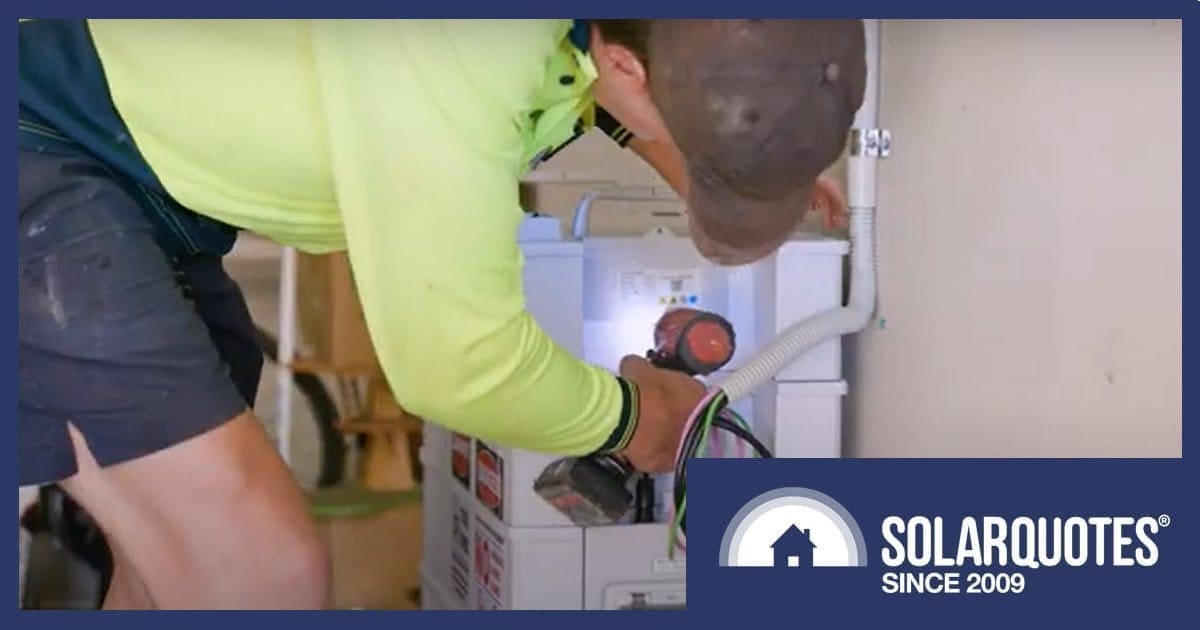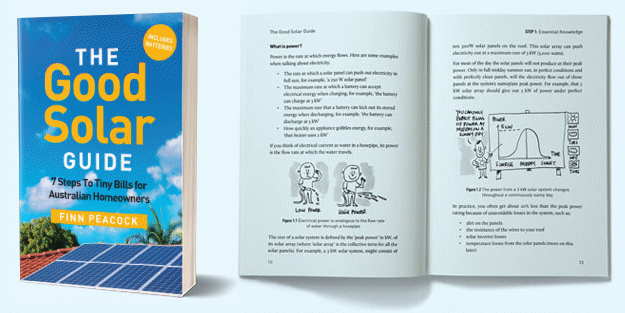
With the official launch of the Australian government’s home battery subsidy, installers are now really under the pump. But there are hard limits on how many installations they can perform in a day set by the powers that be — and with good reason.
Both the Cheaper Home Batteries program and national solar panel rebate are part of Australia’s Small-scale Renewable Energy Scheme (SRES). With so much work around now, some companies could be tempted to cut corners to maximise installations, which is never a good thing.
But there are a bunch of rules installers must follow to stay sweet with the authority overseeing the SRES, the Clean Energy Regulator (CER), and also Solar Accreditation Australia (SAA), which accredits designers and installers. Among those rules are how many systems can be installed in a day.
Installers need to comply with daily installation limits set by SAA to claim Small-scale Technology Certificates (STCs), which are the virtual bits of paper on which the rebates are based1.
Up until June 30th 2025, an accredited person installing or supervising solar system installations only could not sign off on more than two installations per day. And from July 1, 2025 until August 1, 2025, the daily limits are either:
- 2 solar battery systems,
- 2 solar power systems,
- 1 solar power system and 1 battery system,
- 1 solar system plus two additional ‘ready to commission’ batteries,
- 1 battery system, plus two ‘ready to commission’ batteries, or
- Up to 4 ‘ready to commission’ battery installations.
Prior to officially launching on July 1, a bunch of energy storage systems were installed that will be eligible for the rebate assuming the installations weren’t finalised (fully commissioned) before that date. A ‘ready to commission’ battery is considered one only needing final testing and commissioning, i.e. the two earlier stages of work (job setup and mid-installation) were completed previously.
Then from 2 August 2025, the daily installation limits are:
- Two solar systems,
- Two battery systems, or
- One solar system and one battery system.
There are some exemptions — more on the limits and other SAA requirements can be found here.
How Are Installation Dates Verified?
So, what’s stopping installers from installing (for example) two solar power systems and a battery on a single day and then simply fudging the paperwork?
“Selfies” play an important role.
It’s been the case for some years that solar installers are required to take time-stamped photos at each phase of a solar installation and a final ‘completion’ photo matching the test date on the electrical certificate of compliance (or equivalent). More recently, this has extended to battery systems.
To verify installations, the photo’s metadata is examined. This is hidden information embedded within a digital image file that provides details about the photo, such as date, time and location data.
Battery Inspections Start Soon
The Clean Energy Regulator says it will commence conducting inspections on solar battery installations installed under the Cheaper Home Batteries program soon to ensure they meet installation and safety requirements.
“We’ll publish inspection data on our website and share results, including insights on key learnings and risks, with state and territory regulators and authorities responsible for electrical safety and fair trading.”
And the Regulator has a message for both solar retailers and their customers — be patient:
“Consumers can expect that there may be longer than usual wait times for both ordering a new solar battery, or having a new solar battery installed. Solar battery retailers and registered agents can expect delays in processing STCs while we establish our systems.”
While rules around solar and battery installations are strict, it doesn’t mean some don’t have a red-hot go at breaking them. Just recently, a New South Wales man was convicted of multiple offences relating to fraudulent claims under the SRES after a CER investigation. The installer, who didn’t have accreditation, sourced other accredited installers and his employees to sign off on and claim STCs for solar installations he himself completed.
A criminal conviction was recorded for each offence and he copped a $5,500 fine along with a 200-hour Community Corrections order. What was surprising is that this wasn’t his first rodeo. Back in 2019, he was convicted of providing false information concerning eight solar installations, and he was still on a good behaviour bond at the time of his most recent offences.
Footnotes
- Both the solar and battery rebate are offered as an up-front discount to the customer, with the installer/retailer claiming the STCs after installation ↩

 RSS - Posts
RSS - Posts



Who has the honour of ALL ON GOING WARRANTY RESPONSABILTY FOR ALL NEW WORKS INSTALLED(& for how long ?) THE REGISTERED installer plus the Government. Will there be a signed compulsry certificate of verification given to the owner from the REGISTERED INSTALLER. WHO PAYS FOR ANY/ ALL HOUSE FIRES AT THE METERS SITE CAUSED BY A FAULTY UPGRADE INSTALL the installer & or the Goverment.What happens if there is a complete house raised to the ground caused by a faulty or in correct new install ? WHO PAYS UP this time if the Reg/ TRADIE FILES FOR BANK RUPCY his public liability insurer & 0r the government. Will all circuit breakers be newly tagged?
Thanks for the questions. Let’s tackle them one by one:
⸻
1. Who carries the ongoing warranty?
Under Australian Consumer Law (ACL), the business that sells you the battery system is on the hook, even if a separate sparky does the work.
Most battery makers promise 10 years on the product.
2. Will you get a signed certificate?
Yes. Every state and territory Electricity Act (or Regulations) demands a certificate after any new electrical work.
3. Who pays if the meter upgrade causes a fire?
If the fire starts in new work done by the installer, their public-liability insurer is first in line. Your home insurer will often pay you, then chase the installer or their insurer.
4. What if the tradie goes broke?
You still have ACL rights against the business that issued the invoice & the battery manufacturer or wholesaler.
5. Will breakers and RCDs be tagged? Yes.
Why can No one pass on the rebate? 25kwh Sungrow battery is 17000 dollars which attracts almost 9000 of rebate. So 8000ish plus install.
Accredited companies tell you in these qoutes the cost of that battery is30000 ?
So after the rebate and a bit of what ever , your quote is 14500 full install.
So they are still working on a 6000 install fee for what is a simple 20min plug and play . I’d be happy to pay a sparky to install the battery with all checks done but it’s almost cheaper to just buy a battery and stop the installers ripping off the system. If the compony installing handed you 90% of the rebate off the cost I’d but now, in fact sales would go up 600%. Just leads to people buying batteries for themselves to save money.
@dean For the reason outlined in this article. Every man and his dog wants a battery install, and installers are limited in the number of installs/sign offs they can do each day. There are more customers looking for quotes than there are installers available to do the work, so they are confident that at least a few people a day will accept their inflated quotes… so that’s what they quote.
Greed, pure and simple.
Just wait a few months until it the mad rush dies down.
1) How many quotes have you received?
2) Sungrow is on the higher-end of pricing for residential.
3) 20min plug and play… sure…
How about the:
– 30min to send you the quote
– 30min to pass the order with the supplier
– 1hr+ to get the parts
– 30min to drive to your house
– 3hr+ to do a COMPLIANT install
– 15min to clean up all the rubbish after install
– 30m+ drive to dispose of the rubbish
– 30m for the required compliance paperwork post-install so that YOU don’t have to do it to claim YOUR rebate
– 2hr+ to compile all the mandatory documents according to AS 5139 and send them to you with the final invoice.
Sure, you can find cowboys in this industry that will do plug-and-play, in a little more than 20min.
Don’t expect them to come back to fix their mess once it burns down though…
…. yep, some tradies are just slow and disorganised and have little idea of what is actually required …. just bill the customer and take the extras to the ‘tip’!
I saw an article the other day saying after 1 July installs must be done by a licenced electrician now, not just signed off by one.
That will no doubt further constrict things.
It has always been the case, same thing for solar PV.
But cowboys are plentiful in our industry, and people prefer to go to a large retailer and speak to/buy from a salesman rather than a licensed electrician.
The larger the business, the more likely they will send you subcontractors. It goes downhill from there…
“… he was still on a good behaviour bond at the time of his most recent offences.” And then? Loss of licence? Suspended licence? Another fine?
“ cowboys are plentiful in our industry” – no wonder, if they get away with probation and a fine for fraud.
“The Clean Energy Regulator says it will commence conducting inspections on solar battery installations installed under the Cheaper Home Batteries program soon …We’ll publish inspection data on our website …”
Don’t hold your breath. I checked the link Michael provided – it’s published annually on a financial year basis – inspections based on random sampling
So, fyi, Appendix A, table 3 of the latest published update no. 23 covers installs between 1/7/23 to 30/6/24 & lists individual and combined totals for Aust. states and territories in that year – total 42,736 inspections of which 8,302 were ‘substandard’ & 1,115 classed as ‘unsafe’.
To clarify, Appendix A, covers the running totals for states and territories and the combined national total since the commencement of the inspections program in May 2011. So 42,736 inspections Australia wide since then.
Two points to clarify:
1. Appendix A of each annual update, provides the annual totals for ‘substandard’ and for ‘unsafe’ categories of states and territories (No. 23 for the financial year 2023-2024) and
the combined national total of inspections (a running total) since the commencement of the inspections program in May 2011.
So 42,736 inspections Australia wide from May 2011 to 30/6/24 and annual totals for the two categories.
2. The inspections reported in Appendix A of each report are of installations completed in the year prior – so for update no. 23, between 1/7/22 and 30/6/23.
😅